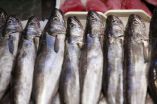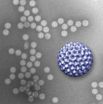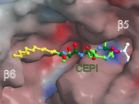(Press-News.org) CAMBRIDGE, Mass. -- In most cities, traffic growth has outpaced road capacity, leading to increased congestion, particularly during the morning and evening commutes. In 2007, congestion on U.S. roads was responsible for 4.2 billion hours of additional travel time, as well as 2.8 billion gallons of fuel consumption and an accompanying increase in air pollution.
One way to prevent traffic tie-ups is to have fewer cars on the road by encouraging alternatives such as public transportation, carpooling, flex time and working from home. But a new study — by researchers at MIT, Central South University in China, the University of California at Berkeley and the Austrian Institute of Technology — incorporates data from drivers' cellphones to show that the adoption of these alternatives by a small percentage of people across a metropolitan area might not be very effective. However, if the same number of people, but from a carefully selected segment of the driving population, chooses not to drive at rush hour, this could reduce congestion significantly.
The study, published in the Dec. 20 issue of the journal Scientific Reports, demonstrates that canceling or delaying the trips of 1 percent of all drivers across a road network would reduce delays caused by congestion by only about 3 percent. But canceling the trips of 1 percent of drivers from carefully selected neighborhoods would reduce the extra travel time for all other drivers in a metropolitan area by as much as 18 percent.
"This has an analogy in many other flows in networks," says lead research Marta González, the Gilbert W. Winslow Career Development Assistant Professor in MIT's Department of Civil and Environmental Engineering. "Being able to detect and then release the congestion in the most affected arteries improves the functioning of the entire coronary system."
The study, designed by González and former MIT postdoc Pu Wang, now a professor at Central South University, is the first large-scale traffic study to track travel using anonymous cellphone data rather than survey data or information obtained from U.S. Census Bureau travel diaries. Both of these are prone to error because of the time lag between gathering and releasing data and the reliance on self-reporting.
González and Wang used three weeks of cellphone data to obtain information about anonymous drivers' routes and the estimated traffic volume and speed on those routes. They inferred a driver's home neighborhood from the regularity of the route traveled and from the locations of cell towers that handled calls made between 9 p.m. and 6 a.m. They combined this with information about population densities and the location and capacity of roads in the networks of two metropolitan areas — Boston and San Francisco — to determine which neighborhoods are the largest sources of drivers on each road segment, and which roads these drivers use to connect from home to highways and other major roadways.
In the Boston area, they found that canceling 1 percent of trips by select drivers in the Massachusetts municipalities of Everett, Marlborough, Lawrence, Lowell and Waltham would cut all drivers' additional commuting time caused by traffic congestion by 18 percent. In the San Francisco area, canceling trips by drivers from Dublin, Hayward, San Jose, San Rafael and parts of San Ramon would cut 14 percent from the travel time of other drivers.
"These percentages are averages based on a one-hour commute with additional minutes caused by congestion," Wang says. "The drivers stuck in the roads with worst congestion would see the greatest percentage of time savings, because the selective strategy can more efficiently decrease the traffic flows in congested roads."
To validate the study's methodology, Alexandre Bayen, an associate professor of systems engineering at Berkeley, and graduate student Timothy Hunter compared González and Wang's estimations of travel time based on cellphone data with their own data obtained from GPS sensors in taxis in the San Francisco area. Using GPS data, Bayen and Hunter computed taxis' speed based on travel time from one location to another; from that speed of travel, they then determined congestion levels. Their findings agreed with those of González and Wang.
Because the new methodology requires only three types of data — population density, topological information about a road network, and cellphone data — it can be used for almost any urban area.
"In many cities in the developing world, traffic congestion is a major problem and travel surveys don't exist," González says. "So the detailed methodology we developed for using cellphone data to accurately characterize road network use could help traffic managers control congestion and allow planners to create road networks that fit a population's needs."
González and Wang are currently studying road use in the Dominican Republic, France, Portugal, Rwanda and Spain. They treat the anonymous cellphone data with the privacy-protection measures required for the treatment of human subjects under an institutional review board.
###
Katja Schechtner, head of the Dynamic Transportation Systems group at the Austrian Institute of Technology and a visiting scholar at the MIT Media Lab, is a co-author on the Scientific Reports paper with González, Wang, Bayen and Hunter.
The study was funded by grants from the New England University Transportation Center, the NEC Corporation Fund, the Solomon Buchsbaum Research Fund and the National Natural Science Foundation of China. Wang received funding from the Shenghua Scholar Program of Central South University.
Written by Denise Brehm END
What is most important when buying fish: the price, the country of origin, whether it is fresh or frozen or whether it is wild or farm-raised? The average Spanish consumer prefers above all that their fish comes from Spain, according to a study published in the 'Food Quality and Preference' journal. Spain is the largest producer of fish in the European Union but in recent years its population has consumed less fish, especially seafood.
A team of scientists brought together nearly 900 consumers from nine Autonomous Communities (Andalusia, Asturias, the Balearic Islands, ...
CAMBRIDGE, Mass. -- Following up on earlier theoretical predictions, MIT researchers have now demonstrated experimentally the existence of a fundamentally new kind of magnetic behavior, adding to the two previously known states of magnetism.
Ferromagnetism — the simple magnetism of a bar magnet or compass needle — has been known for centuries. In a second type of magnetism, antiferromagnetism, the magnetic fields of the ions within a metal or alloy cancel each other out. In both cases, the materials become magnetic only when cooled below a certain critical temperature. ...
If the key to winning battles is knowing both your enemy and yourself, then scientists are now well on their way toward becoming the Sun Tzus of medicine by taking a giant step toward a priceless advantage – the ability to see the soldiers in action on the battlefield.
Investigators at the Virginia Tech Carilion Research Institute have invented a way to directly image biological structures at their most fundamental level and in their natural habitats. The technique is a major advancement toward the ultimate goal of imaging biological processes in action at the atomic ...
We use many different types of chemicals and plastics for the convenience of our everyday life. The current sources of these materials are provided from petrochemical industry, using fossil oil as a raw material. Due to our increased concerns on the environmental problems and fossil resource availability, there has been much interest in producing those chemicals and materials from renewable non-food biomass through biorefineries. For the development of biorefinery process, microorganisms have successfully been employed as the key biocatalysts to produce a wide range of ...
PHILADELPHIA—Researchers at the Kimmel Cancer Center at Jefferson (KCC) (insert link to "Kimmel Cancer Center at Jefferson" www.kimmelcancercenter.org) have developed potentially game-changing diagnostic and prognostic genetic tests shown to better predict prostate cancer survival outcomes and distinguish clinically-relevant cancers.
The team, led by Richard G. Pestell, M.D., Ph.D., Director of the KCC and the Chair of the Department of Cancer Biology at Thomas Jefferson University, report their preclinical findings from a blinded, retrospective analysis of over 350 ...
As the human population increases, so too do the demands and stresses on agriculture. In the January 2013 issue of International Journal of Plant Sciences, Penn State University Waller Professor of Plant Biology Dr. Sarah Assmann explores how the responses to environmental stresses by one small, genetically diverse plant species might illuminate possible approaches to addressing growing human demand for crop products amid decreasing resources.
In the article, Dr. Assmann describes how human population growth presents new challenges to twenty-first-century agriculture, ...
A University of Colorado Cancer Center study in this month's edition of the Journal of Investigative Dermatology describes a new target and potential treatment for melanoma, the most dangerous form of skin cancer. MicroRNA can decide which genes in a cell's DNA are expressed and which stay silent. Melanoma tends to lack microRNA-26a, which makes the gene SODD go silent.
"It's a double negative," says Yiqun Shellman, PhD, investigator at the CU Cancer Center, associate professor at the CU School of Medicine, and the study's co-senior author. "miR-26a works to stop the ...
New research examining the role of race and ethnicity in an individual's decision to become a donor for hematopoietic cell transplantation (HCT) identifies several factors associated with varied participation rates in national donor registries across racial/ethnic groups. Results of this first-of-its-kind study are published online today in Blood, the Journal of the American Society of Hematology (ASH).
Hematopoietic cell transplants serve as valuable treatments for a range of blood disorders, as they generate new, healthy blood cells to replace diseased cells. While ...
This press release is available in German.
In their quest for new agents, pharmaceutical researchers test millions of substances all over the world. They like using color-forming reactions to identify new molecules. However, in intensively colored solutions or in the case of mixtures with multiple substances these tests fail. As part of his doctoral thesis, Martin Stein, member of staff at the Chair of Biochemistry at the Technische Universitaet Muenchen, developed a testing reaction based on magnetic resonance data. It helps find a specific pharmaceutical molecule ...
The Seventies: Smog alert in the Ruhr area, acid rain, dying spruce trees in the Bavarian Forest. In those days, the solution was filter systems for the smokestacks in the Ruhr area. Today, people in the urban areas are suffering from high levels of pollution that is being caused by, among other things, automotive traffic. Particularly undesired: the nitrogen oxides (NOX). In the meantime, the European Union tightened the limit values even further; in many communities they are being exceeded. Michael Hüben of the Fraunhofer Institute for Molecular Biology and Applied Ecology ...




